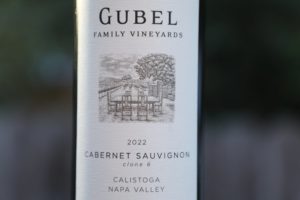
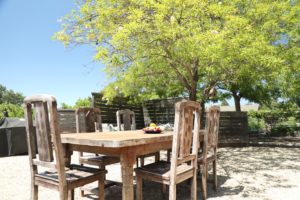
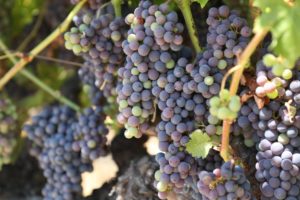 Gubel Family Vineyards was founded by Gustavo Gubel and Joanne Hoffman with their first vintage in 2021; he an architect who operates Gubel and Associates in Los Angeles, a firm responsible for designing numerous residences and commercial buildings in Los Angeles, and she an entertainment lawyer, operating Hoffman Entertainment Law. The story that eventually led them to Napa Valley began several decades prior. Gustavo purchased an empty piece of land in the Silverlake neighborhood of Los Angeles. He designed and began overseeing the construction of their home. A mature olive tree grew on the property located right next to where part of the foundation was slated to be poured. They weren’t able to save the tree, but he had his construction workers harvest the olives during the day. The tree was cut down later that night.
Gubel Family Vineyards was founded by Gustavo Gubel and Joanne Hoffman with their first vintage in 2021; he an architect who operates Gubel and Associates in Los Angeles, a firm responsible for designing numerous residences and commercial buildings in Los Angeles, and she an entertainment lawyer, operating Hoffman Entertainment Law. The story that eventually led them to Napa Valley began several decades prior. Gustavo purchased an empty piece of land in the Silverlake neighborhood of Los Angeles. He designed and began overseeing the construction of their home. A mature olive tree grew on the property located right next to where part of the foundation was slated to be poured. They weren’t able to save the tree, but he had his construction workers harvest the olives during the day. The tree was cut down later that night.
Gustavo hauled loads of olives into their living room and told Joanne they would going to be making olive oil that night. So they used several short two-by four pieces of wood to by hand, pound and mash up the olives and pits; Joanne recalls assisting with this messy process until late at night. When they woke up the next morning they discovered a tiny layer of olive oil had risen above the pomace. So they scooped off the olive oil; it wasn’t much. Their passionate efforts produced a small amount, only filling a tiny bottle about 1/3 of the way. But it had an amazing taste and both agreed that someday they would produce more of it, but in larger quantities.
Prior to their wedding Joanne began thinking about the type of gifts they could offer their guests. She thought it might be a nice touch to buy small olive trees. So she sent Gustavo up to Santa Cruz to Santa Cruz Olive Tree Nursery with the instructions to buy about 130 small trees. He returned to Los Angeles with well over 350 tiny trees, all Italian varieties including Frantoio, Pendolino, Leccino & Morailolo. Limited in space on their property, planting a grove of olive trees was out of the question. So they became creative and moved all the trees to the roof of their house and rigged up a hose and a ladder for ease of access. This was a time when cultivating marijuana plants for home use was illegal and Gustavo remembers on multiple occasion helicopters flying low over their house to get a glimpse of their rooftop grove of olive trees.
After several years the olives outgrew the roof. It was time to find another home. So Gustavo began to look for land and located an individual in Ventura County who was willing to barter with him – land for the olive trees in exchange for an architectural design. The trees were hauled to this property, planted in larger pots and repotted several more times over the years until they were growing in large wooden crates. They were never planted in the ground. Gustavo would often drive up on the weekends to oversee their growth including installing an irrigation system.
When the trees reached maturity, Joanne and Gustavo began to harvest and produce olive oil. Their production yielded hundreds of small bottles each year. They named the wine Olielle, using parts of each of their daughters first names. And the label for this brand was drawn by one of their daughters at age 8.
After twenty years the roots started to break through the wooden crates. They realized they needed to find a permanent home for them; Gustavo traveled around the state looking for a place to plant the trees while in the back of his mind, he thought about someday producing wine. He and Joanne discovered a piece of property for sale in Calistoga in 2020. They purchased the site with the existing vineyard that year; one of their priorities soon after purchasing it was to convert its farming to organic. They applied for CCOF, usually a three year approval process and received their certification in 2025.
Gustavo began to learn the business of wine growing. He took classes in enology and viticulture at Napa Valley College and also enrolled at the Napa Valley Wine Academy. Vineyard manager Ignacio Tejeda oversees the management of the vines; in fact he planted this vineyard in 2000 when he worked for Araujo Estate (now Eisele Vineyard). When the former owners informed Ignacio they had sold the property he felt complete sadness; but this soon changed to joy when he heard that Gustavo and Joanne wanted both keep the vineyard and retain his viticultural services.
Gustavo and Joanne interviewed several winemakers; Gustavo recalls as soon as he met winemaker Robbie Meyer, he knew he was the one to oversee their winemaking. Meyer is co-owner of Peirson Meyer Wines and longtime consulting winemaker to a number of premium, primarily Napa Valley based producers.
The Gubel property is about 5 acres of which four acres are planted entirely to clone 6 Cabernet Sauvignon. The grapes were sold for many years to Gamble Family. No wine was produced in 2020 due to the resulting smoke from the nearby fires.
Clone 6 Cabernet Sauvignon
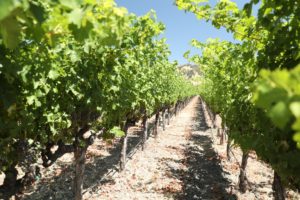
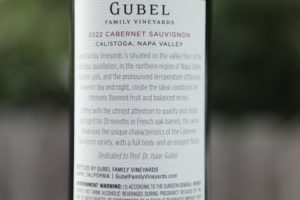 Clone 6 Cabernet Sauvignon in Napa Valley is originally rooted with one individual, winemaker Anthony Bell. In late 1979 Bell began what became instrumental research on clonal variations of Cabernet Sauvignon while working at Beaulieu Vineyard. He is most known for introducing Clone 6 to Napa Valley; in 1980 he oversaw the planting of 14 unique clonal selections of Cabernet Sauvignon for Beaulieu Vineyard and then after several years, harvested, fermented separately and produced an individual wine from each clone.
Clone 6 Cabernet Sauvignon in Napa Valley is originally rooted with one individual, winemaker Anthony Bell. In late 1979 Bell began what became instrumental research on clonal variations of Cabernet Sauvignon while working at Beaulieu Vineyard. He is most known for introducing Clone 6 to Napa Valley; in 1980 he oversaw the planting of 14 unique clonal selections of Cabernet Sauvignon for Beaulieu Vineyard and then after several years, harvested, fermented separately and produced an individual wine from each clone.
One of the clones caught his attention; this was clone 6 Cabernet Sauvignon also called the Jackson clone. It had come to California originally from Bordeaux sometime during the gold rush years and was taken as a cutting from a single vine in an abandoned field station near the town of Jackson in the Sierra Nevada foothills. His propagation of this clone was the first time it has been planted in California since after the Gold Rush. Unlike other clones of Cabernet Sauvignon in which the bunches of grapes are tightly packed, these grapes grow in loose clusters and as a result, visually are fairly easy to identify. And this clone is known for its low yields.
After tasting through all the separate wines in multiple blind tastings it was clone 6 Cabernet Sauvignon that repeatably stood out – a wine that kept eliciting the word ‘wow’. In the 1980s, grape grower John Baritelle worked with Bell and Beaulieu Vineyard to grow Cabernet Sauvignon clone 6. In 1991 Anthony harvested and produced the first single-vineyard single-clone Cabernet Sauvignon from Napa Valley.
Several quick definitions are in order relating to clones. A variety is a specific type of grape with its own overall inherent characteristics; IE Cabernet Sauvignon is a variety and is a different grape versus Malbec. A clone refers to plant material from a variety that displays unique and or distinctive characteristics as compared to other clones from that variety. Clones are created through genetic mutations over periods of time. This can be shape of clusters, flavors, grape size, drought tolerance, differences in times of ripening or resistance to disease among other attributes. And another related word is ‘selection’ – this term refers to cuttings taken from an existing vineyard (regardless of variety or clone) which are then propagated in a new vineyard: IE a Cabernet Sauvignon selection from Eisele Vineyard.
Select Wines
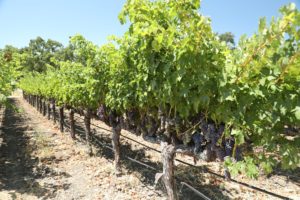 The 2022 Gubel Family Vineyards Clone 6, Cabernet Sauvignon Calistoga is deep ruby and opaque; ripe, generous and sweetly fruited, the fruit is the star here and sits center stage on the bouquet. The first scent we noted is of ripe plum, accompanied by boysenberry jam, dark raspberry, mid summer wild blackberry at the peak of ripeness, Persian mulberry and cherry pie. As the wine evolves it opens to a note of baker’s chocolate and a light touch of baking spices including cloves and nutmeg. Superbly balanced in its youth, the palate doesn’t show as ripe as the bouquet might lead one to believe, as it is led by a bright acidity. It is important to note that careful canopy management was an important part of preserving the grapes this year due to the severe and extended heat spike centered around Labor Day weekend. Its flavors include red cherry, plum, currant, raspberry, blackberry and tobacco. Minerally. Savory. The broadly spread tannins continue to persist beyond the fruit on the finish with a gravelly, grainy, and highly dusty and chalky character. Chewy. One can texturally feel the high skin to juice ratio in this wine. It was aged for 20 months in French oak barrels. Wagyu steak on a BBQ covered in an assortment of a spicy herb based dry-rub, a warm summer evening and a pool sounds like the ideal pairing.
The 2022 Gubel Family Vineyards Clone 6, Cabernet Sauvignon Calistoga is deep ruby and opaque; ripe, generous and sweetly fruited, the fruit is the star here and sits center stage on the bouquet. The first scent we noted is of ripe plum, accompanied by boysenberry jam, dark raspberry, mid summer wild blackberry at the peak of ripeness, Persian mulberry and cherry pie. As the wine evolves it opens to a note of baker’s chocolate and a light touch of baking spices including cloves and nutmeg. Superbly balanced in its youth, the palate doesn’t show as ripe as the bouquet might lead one to believe, as it is led by a bright acidity. It is important to note that careful canopy management was an important part of preserving the grapes this year due to the severe and extended heat spike centered around Labor Day weekend. Its flavors include red cherry, plum, currant, raspberry, blackberry and tobacco. Minerally. Savory. The broadly spread tannins continue to persist beyond the fruit on the finish with a gravelly, grainy, and highly dusty and chalky character. Chewy. One can texturally feel the high skin to juice ratio in this wine. It was aged for 20 months in French oak barrels. Wagyu steak on a BBQ covered in an assortment of a spicy herb based dry-rub, a warm summer evening and a pool sounds like the ideal pairing.
The 2021 Gubel Family Vineyard Cabernet Sauvignon clone 6, Calistoga Napa Valley is deep ruby; the bouquet is elegant showing a characteristic Calistoga ripeness but not being overripe. Its scents include red cherry, plum, dark raspberry, boysenberry and dark currants with a light note of dried herbs. The bouquet is focused on its core fruit with the oak providing a gentle presence in the background. On the palate there are fully coating flavors of dark raspberry, cherry, red plum and red currant. Finishes lightly spicy with a note of dried herbs and a dusty nuance. In terms of mouth feel, this wine shows much softer than the 2022 vintage (an opposite character of these two vintages in Napa Valley). The tannins are ripe, rounded and perfect spheres on the palate. Their texture lingers softly in tandem with fruit on the finish with a light gravelly character. Features a bright and balanced acidity. At four years post vintage, this wine falls into the territory of being crowd friendly. After a 16-day fermentation, the wine was pressed off to barrel and aged for 20 months in a combination of both 50% new and neutral French oak barrels.
The wines are dedicated to Gustavo’s father, professor Dr. Isaac Gubel, a self made international psychiatrist from Argentina who sent Gustavo to California in the 1970s to study architecture, to escape Argentina’s political unrest at the time. For reference, this was an uneasy time to be living in Argentina, a period of history known as the ‘dirty wars’, an era of state sponsored terrorism.
—
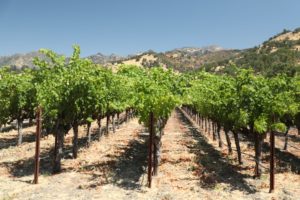 Steve Noble, a prolific illustrator drew the design for their wine label featuring a bucolic scene that could be part of most wine regions around the world. But in this case it is their back yard in Calistoga including a wooden table, part of their vineyard and an an almond tree. The image of the table is particularly special; it was the first piece of furniture that Joanne purchased at age 25 for her home in Laurel Canyon (Los Angeles). Noble’s clients list is a whose who including major corporations, international companies and prominent wineries including locally, Cakebread Cellars and Beulieu Vineyard.
Steve Noble, a prolific illustrator drew the design for their wine label featuring a bucolic scene that could be part of most wine regions around the world. But in this case it is their back yard in Calistoga including a wooden table, part of their vineyard and an an almond tree. The image of the table is particularly special; it was the first piece of furniture that Joanne purchased at age 25 for her home in Laurel Canyon (Los Angeles). Noble’s clients list is a whose who including major corporations, international companies and prominent wineries including locally, Cakebread Cellars and Beulieu Vineyard.
For the first three vintages the wines were made at Brasswood in St. Helena. Starting with the 2024 vintage, winemaking moved to Shadybrook Estate in Coombsville. Total production each year varies slightly but is usually around 200 cases. If they fully utilize all the grapes from the property they could produce around 1,000 cases annually; the plan is to grow the production slowly. A bottle of their estate olive oil is included with all orders of a case or more.
The wines are selectively distributed in parts of California including at Outer Space Wines in downtown Napa, The Lodge at Bodega Bay in neighboring Sonoma County, Dewz Restaurant in Modesto, Hop & Vine in San Jose, the Four Points Sheraton in Santa Cruz and at Holiday Wine Cellar, a retailer in Escondido. For more information, to purchase the current release, or to join their wine club with the option of 6 or 12 bottles per shipment twice a year, visit: www.gubelfamilyvineyards.com

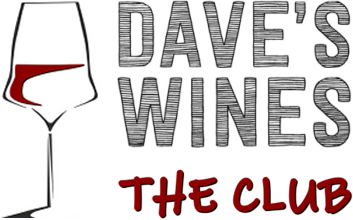




Leave a Reply